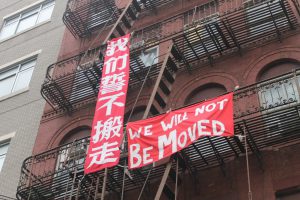The first time I went to Hunts Point was in 2009 when I was 12 years old. My father had learned of a chrome plating business on the small Bronx peninsula where he sought to get our bathroom sink’s tarnished legs rebuffed by professionals. After briefly seeing the workers doing the nasty business of chrome buffing, a toxic process involving exposure to noxious carcinogens, we decided to walk up the street and kill some time. I vividly remember my young mind being interested in a Sabrett Hot Dogs food distributor on Spofford Avenue, just before looking across the street at a sprawling, foreboding complex of white brick buildings guarded by rusted concertina wire. Austere in its design, this menacing complex scared me. “Dad, what is that place?” I asked. Continue reading “The Story of the Bronx’s Spofford Juvenile Detention Center”
Jonathan Marty
Chinatown Hunger Strike: The Crisis of 83-85 Bowery

On January 18th, over 80 people were evicted from their homes at 83-85 Bowery in Chinatown by landlord Joseph Betesh. Claiming that 85 Bowery’s staircase was structurally unsound, Betesh ordered the low-income tenants of both buildings out of their homes into the freezing winter cold. The vast majority of those displaced were housed in rat-infested hotel-turned-homeless shelter seven miles away in Brownsville, Brooklyn. On Thursday, February 8th, four of the tenants will begin a hunger strike to pressure the Department of Housing Preservation and Development to repair the neglected building and prosecute Betesh for his slumlord tactics.
Continue reading “Chinatown Hunger Strike: The Crisis of 83-85 Bowery”
“El Barrio No Se Vende!”: Righteous Uproar at an East Harlem Rezoning Hearing
At noon on October 11th, a hearing was held at New York City Hall to discuss the proposed rezoning of Manhattan’s East Harlem. The widely controversial plan, which calls for the upzoning of a 96 square block of the neighborhood also known as El Barrio, makes way for an astonishing 122,000 square feet for new restaurants and stores, 275,000 square feet of new industrial and office space, as well as 3,500 new apartment units. Despite ongoing backlash from El Barrio residents who fear that an remodeling of the working class, historically Latino neighborhood would displace longtime residents and destroy the character of the community, the plan was approved by the City Planning Commission nine days before the hearing.
Naturally, gaggles of protesters waited outside the gates of City Hall prior to the event, many holding signs with slogans like “East Harlem is Not For Sale!” and “Mayor De Blasio, What’s in Your Wallet?” Protesters from groups like the Community Voices Heard (CVH) and the People’s Congress of Resistance made the rounds handing out literature detailing their opposition to the plan. One particularly striking piece featured the headline “TIME TO FIGHT BACK! Federal gov’t lets Puerto Rico starve – NYC gov’t drives Boricuas, poor people out of El Barrio with ‘rezoning’ plan.” Continue reading ““El Barrio No Se Vende!”: Righteous Uproar at an East Harlem Rezoning Hearing”
The Future of The Hole: New York City’s Most Forlorn Bordertown
Situated in a grim, nondescript corner of the wealthiest city in America, miles away from the shining skyscrapers of Park Avenue and the cocktail parties of Wall Street, there is a place known simply as “The Hole.”
Long known as body dumping ground for mobsters, the Hole lies far below grade level, lacks basic 21st century necessities like plumbing and street drainage, and is scarred by various failed and/or incomplete attempts at development and improvement. In the middle of a rapidly progressing metropolis, the Hole remains a fascinating example of a land that time seems to have forgotten — and one whose attempts to modernize have been fraught with corruption, neglect, and general dysfunction.
Continue reading “The Future of The Hole: New York City’s Most Forlorn Bordertown”
